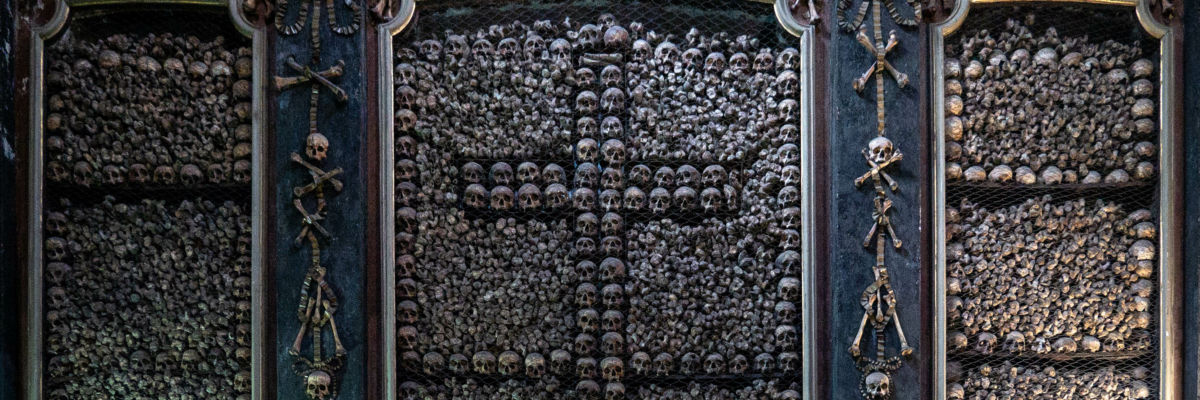
Having shrugged off holy things, the world likes to stamp its own image on Christian holidays (while accusing the Church of doing that in reverse). Every October 31, for example, it replaces the holiness of All Hallows Eve with a tableau of blood, gore, and fear.
But the great irony is that when it comes to the secular “virtues” of Halloween, Catholics beat the secularists at their own game. Our martyrs’ deaths are bloodier and scarier than any gore-fest the fevered brains in Hollywood can come up with. They’re also better stories—true romances, where heroes give up everything for what matters most.
The examples of inspiring martyrs who went willingly into truly grotesque tortures could fill up a thick book (and do). But here are five that will give you a taste of the things Catholics have endured to be witnesses for Christ.
-
St. Denis (third century), feast day October 9
There are shades of The Legend of Sleepy Hollow in the legend of St. Denis—which, really, you can’t get any more Halloween than that. In Washington Irving’s classic, a fearsome mounted ghoul launches his own severed head at Ichabod Crane, knocking the latter off his steed and into an unknown fate. Denis, an early bishop of Paris also rendered decollato, used the event more profitably. As the legend has it, the freshly decapitated saint picked up his head and walked a good distance with it, preaching the gospel the whole way.
Starting with Denis’s beheading, though, sells him short: the French bishop and his companions “were scourged, imprisoned, racked, thrown to wild beasts, burnt at the stake, and finally beheaded.”
He’s also the patron saint against demons (appropriate) and headaches (hilarious), so it turns out you can get more Halloween than that.
-
Ss. Chrysanthus and Daria (d. 283), feast day October 25
Louis and Zélie Martin get the most acclaim as married saints, but they’re not the only ones. The martyrdom of spouses Chrysanthus and Daria is a tear-jerker, the perfect fodder for an Oscar in a more virtuous age. Chrysanthus was the son of a pagan patrician, Daria a priestess of the goddess Minerva. The SSPX missal says Daria converted Chrysanthus; the Russian Orthodox cathedral in D.C. says Chrysanthus converted Daria. Regardless, as the Roman Martyrology puts it:
After several torments which they endured for Jesus Christ under the prefect Celerinus, they were condemned by the Emperor Numerian to be thrown into a sandpit on the Salarian Way, and buried alive there under a heap of earth and stones.
Not a pretty way to go, no matter how nonchalantly the Martyrology puts it. How heartbreaking, and how beautiful, to consider that the two spouses, horrifically tortured, comforted each other in their last moments.
-
St. Edmund Campion (1540-1581), feast day December 1
Anyone whose take on England ends at quaint old ideas of chivalry and gentlemanliness should try touring the Tower of London. However much they love their fancy tea, the English also came up with some of the most horrific methods of torture to spring from man’s imagination.
One of these, drawing and quartering, was the lot of St. Edmund Campion, a hero-priest of the English Reformation. Condemned for providing clandestine sacraments to England’s oppressed Catholics—what the government prosecutors called high treason—Edmund
was drawn to the place of execution, tied to the hurdle or sledge which was dragged by a horse. . . . Once there, the prisoner(s) were hanged in the normal way (i.e. without a drop to ensure that the neck was not broken) but cut down whilst still conscious. . . . The intestines and heart were removed and burned before them. The other organs were torn out and finally the head was cut off and the body divided into four quarters.
And the above paragraph is the sanitized version. If you want to see what’s behind the ellipses, you can click the link, but trust me: you don’t want to see what’s behind the ellipses.
-
St. Isaac Jogues (1607-1646), feast day October 19
The Jesuit missionary to seventeenth-century Canada’s Indian tribes is best known for his fingers, or lack of them: as part of a series of tortures, a tribe of Mohawks mutilated Isaac’s hands. He survived that encounter and made it back to France, where his greatest regret was not the loss of his fingers, but the inability to say the Mass. Proving how seriously he took the rubrics of the liturgy, he begged for—and received—a dispensation from Pope Urban VIII to celebrate the sacrament in spite of his handicap.
That would be enough for a Halloween article, but Isaac’s story doesn’t end there. No, he went back to Canada to save more heathen souls. After a second capture and (you guessed it) another series of horrific tortures, including flaying, from the Mohawks, he achieved the crown of martyrdom.
-
The Japanese martyrs . . . so many martyrs (ca. 1597-ca. 1873), feast days all over the calendar
The English had a knack for stomach-turning forms of torture. The Japanese were no slouches, either.
You might read about Bl. Melchior of St. Augustine, burned at the stake—once again, after “various forms of torture”—in Nagasaki in 1632. It took him four hours to die; his companion, Bl. Martín Lumbreras, lasted for eighteen. Then you’ll notice sixteen martyrs, then twenty-six others, then 188 martyrs, then 205 martyrs. And these represent only a small fraction of the total number of Christians slaughtered in Japan—burned, mutilated, immersed in sulfate, crucified, stabbed with lances, beheaded. One boy
offered his bare neck to the astonished executioners. They did not aim correctly the first time, wounding him in the shoulder and causing him to fall to the ground. But the boy got up immediately and knelt again in prayer. He was beheaded with the names of Jesus and Mary on his lips.
The Catholic Encyclopedia says, “There is not in the whole history of the Church a single people who can offer to the admiration of the Christian world annals as glorious, and a martyrology as lengthy, as those of the people of Japan.” For all the gore you’ll find in the harrowing stories of these witnesses, their holy perseverance eclipses their tortures many times over.
It’s like that with all the martyrs throughout Catholic history. When you read of them, you start to see how cheap, lame, and ultimately boring the modern culture’s senseless gore is. What a brilliant contrast is the gore of the martyrs, the violence with which vicious heathens, pagans, and governments sought to wrest them from their faith. It’s the opposite of senseless—it has a purpose so glorious that even as we cringe at the inhumanity of these heroes’ ends, we also weep for the beauty of their steel-spined loyalty to the one true God.
So let the secularists have their Halloween to turn the stomach—but let them have it in the proper All Hallows Eve, sanctified by the blood and gore of the martyrs, with stomachs turned and hearts uplifted, too.
Image: Ossuary at San Bernadino alle Ossa in Milan, Italy.



